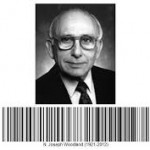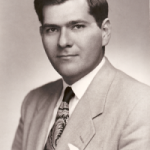Tuesday, October 13, 2015
At 8 am on In June 26, 1974, a 10-pack of Wrigley’s Juicy Fruit Gum imprinted with a bar code was scanned by a UPC scanner in Marsh’s supermarket in Troy. . . Ohio. (Darn! So close and yet so far!) This simple historic event changed how merchandise, industrial products, library books, medications and patients in hospitals, theater tickets, and almost anything else you can imagine is inventoried, tracked, priced, or catalogued.
While the concept of a coded system for product information originated during the Great Depression, the bar code we use today was developed after World War II. Joseph Woodland and Bernard Silver, both graduates of the Drexel Institute of Technology in Philadelphia, developed the system between 1948 and 1974. They modified the dots and dashes in Morse code into black lines and white spaces. The first scanners for interpreting he code used high wattage light bulbs. Helium neon laser scanners were developed in the 1960s. Soon the single bean scanner was replaced by scanners with multiple beams to make reading the bar codes faster and easier.
When a bar code is scanned the laser interprets the width of the black lines; each number has its own specific width. The white spaces tell the laser were one number ends and the next begins. Any string of numbers in any order or length can be scanned against a database of information to account for inventory, sales, and purchases. Today we use a standardized 11 digit code that identifies any unique product. This code is referred to as the UPC, or Universal Product Code.1
Photos:
Joseph Woodland
Bernard Silver
Sources:
https://inventors.about.com/od/bstartinventions/a/Bar-Codes.htm
https://www.barcodesinc.com/articles/barcode-history.htm
To commemorate the City of Troy’s 60th Anniversary in 2015, we will publish a different story each day that highlights a person, discovery, or event that occurred locally, regionally, nationally, or even globally between 1955 and 2015 and that helped shape our lives and our community. We will try to post stories on important anniversary dates, but we also realize that dates are less critical than content and context. We will include the facts related to controversial stories, allowing our readers to form their own opinions. We invite you to read and comment on the stories. Your suggestions for topics are also welcome and can be posted on our Facebook page, www.facebook.com/TroyHistoricVillage. You can also email stories or ideas to the 365 Story Editor at ed@thvmail.org.








